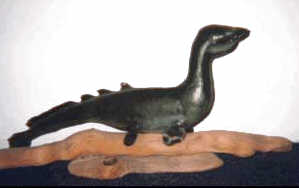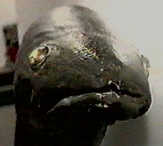

|
|
Alleged Lake Erie Monster |
Part of Kuban's Paluxy web site
In the late 1990's strict creationist Carl Baugh began to promote an alleged baby "lake monster" as anti-evolutionary evidence. Sometimes called the "Erie Baby," the approximately 3 feet long carcass had reportedly washed up on the shore of Lake Erie around 1992, at which time it was found and then stuffed by taxademinst Larry "Pete" Petersen, who displayed it in his "L & D Bait and Tackle" shop near Cleveland, Ohio.*
Somehow Carl Baugh of Texas got word of the creature, and traveled from Texas to Petersen's shop to examine it. During his visit Baugh purchased the specimen from Petersen and subsequently displayed it in his Creation Evidence Museum in Glen Rose, Texas, evidently accepting the oddity as a real, plesiosaur-like lake monster.
Around the same time strict creationist Kent Hovind began to promote the creature in a similar manner in his seminars. A photograph of the stuffed creature appears on his website, where he states the following:
In 1998, I talked to Pete Peterson who lives in Cleveland, Ohio.
He said he was walking on the beach about six years earlier and
found a dead baby creature three feet long. The seagulls had been
pecking at it. Pete took it home with him and mounted it. He’s a
taxidermist. He said this creature was lying on the beach of Lake
Erie. Strange looking little fellow. Four flippers and has a tail
sort of like a fish. He said it had something like pouches on the
side of its cheeks. Carl Baugh bought it and it’s in the museum in
Glen Rose, Texas now. They’ve done a DNA analysis and a CAT scan
x-ray. It had a fish hook stuck up in its head. Apparently somebody
caught it sometime in the past and broke the line. The fish hook is
still in there, it shows up on the CAT scan. Strange little critter.
(Hovind, 2002-2006)
Upon hearing of Baugh's "find" I telephoned Petersen, whose shop happened be not far from where I lived at the time. As I inquired about the "monster" Petersen related that he did indeed find the carcass washed up on the shore of Lake Erie, and that he sold it to Baugh during Baugh's visit. Petersen was surprisingly candid about the manner in which he had processed the carcass. He said that when he found it, it was already decaying and had been "pecked at" by birds, but was evidently some kind of fish, with a hook still in its mouth. He said that he decided to stuff it and fashion it into a sea-serpent like creature as an attention-getting display for an upcoming taxidermy trade show. He said it had a long fin along the rear part of the body, which he notched into triangular shapes to make it appear more dragon like. He also bent and sewed the neck into an S-shape to foster the same impression, and finally, sewed little pieces of skin to form little flippers. He said the display--which was basically a "joke"--was a hit, and that many people at the trade show enjoyed it, especially children. He said he did not think anyone would take it seriously, until Baugh showed up, and seemed to assume it was a real lake monster, and wanted to buy it. I asked if he knew what species of fish it was. Despite being a taxidermist, Petersen said that he was unable to identify it.
Although I myself am an avid fisherman and have caught many different species of fish in Lake Erie over the years, I did not immediately recognize the species either. However, after doing some research into freshwater fish whose body shapes and fins were compatible with the carcass in question, I concluded that it was almost certainly a long-bodied, somewhat eel-like fish called a burbot, whose scientific name is Lota lota, and which can grow to 36 inches or more in length. Also known as an eelpout, ling, lingcod, and lawyer fish (among other names), it is one of the few fresh-water relatives of ocean cod, and is less common than most Lake Erie species (usually preferring deeper, cooler waters), but is known to exist in Lake Erie.

|
| Burbot or Lawyerfish (Species Lota lota) |

|
| Face of the "Erie Baby" carcass, showing the same features as a burbot. Photo from Creationseminar.net website (Groham, 2005). |
Hovind states that DNA analysis and a CAT scan was conducted on the specimen, but does not provide the results. However, in 2005 I discussed the specimen with David Woetzel, whose own web site once encouraged the idea that the creature was some kind of lake monster. I related to Woetezel my research indicating the creature was an altered long-bodied fish. Soon afterward Woetzel related that he had discussed the matter with Baugh, who told him that the had concluded the creature was some kind of "eel." To Woetzel's credit, he soon removed the section of his website regarding the creature. Evidently Baugh himself no longer promotes the carcass as a baby lake monster, nor have any major creationist groups, although as of 2006, a web site featureing Hovind's claims still does (Snoeck, 2002-2006).
Of course, even if Baugh had not recognized anything "fishy" about the carcass, it would have behooved him do more research before purchasing it and advocating it as a lake monster. After all, it was not many years earlier that what he promoted an alleged "human tooth" found near dinosaur tracks in the Paluxy Riverbed of Texas. The tooth turned out to belong to a Cretaceous fish.
Baugh then relates that he took the x-rays and specimen to the head of a "Marine Biology Department" at a "major state university" who was excited about the specimen, suggesting it was a "throwback" to early marine evolution. However, Baugh did not reveal the name of the biologist, or the name of the university. Nor does he reveal the name of another "marine biology department" head he subsequently showed the specimen to, who reportedly was unable to give any identification. Baugh then writes that a "credentialed microbologist" (again, no name mentioned) from a "third major university" (also unspecified) reported that the taxidermist's acid had destoyed any DNA in the specimen, but believe the specimen was an unclassified eel, "deserving of technical publication." It this account is accurate, it seems surprising that neither Baugh nor the biologists he visited bothered to compare the specimen's head with known fish from the Great Lakes, which would have readily revealed that it was a modified burbot fish (as would a web search that would have led them to this article).
Instead, Baugh seems to leave the impression that the carcass represents an exotic prehistoric "throwback" unknown to science. Further fostering this impression, Baugh recounts being referred to a "reliable individual" who reported seeing a creature identical (except larger) in "a lake in southern Canada." However, if this account is true, one must wonder why Baugh again refrains from naming the individual involved, or even the name or specific location of the lake. One must also wonder, if Baugh really wanted to know or share the whole truth about this specimen, why he seems reluctant to contuct further research. He relates that the Canadian witness invited him to speed a few weeks at the lake searching for the creature, but that this was "not the specific nature of our research." Baugh ends by stating that he is content in calling the "exotic unclassified eel" just "Baby Erie."
The carcass once advocated by Carl Baugh and Kent Hovind as a probable "lake monster" from Lake Erie, and more recetnly suggested by Baugh to be an unclassified exotic eel, is evidently merely the altered remains of a long-bodied fish known as a burbot.
* L & D Bait and Tackle is located at 18508 Detroit Avenue, Lakewood OH 44107, Phone (216) 226-3474
Michel Snoeck. 2002-2006 web page: http://www.algonet.se/~tourtel/hovind_seminar/seminar_part3b.html. This site promotes many claims by Kent Hovind.
Grohman, Steve, 2005, website: http://creationseminar.net/dino_clips.htm. 2006 note: Mr. Grohman removed the Erie baby page in 2006. In email correspondence Grohman indicated that he did this because questions were raised about the specimen.